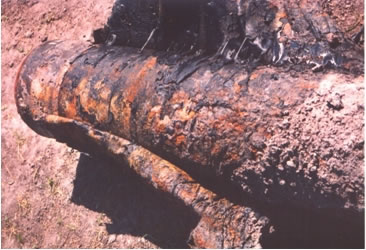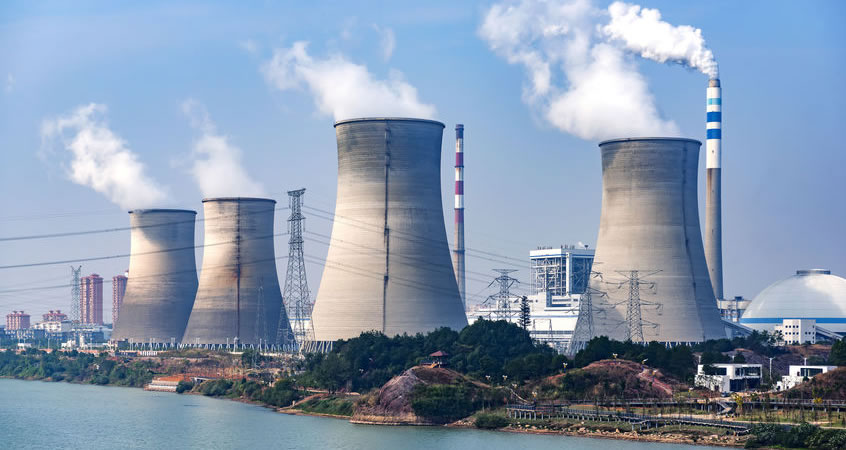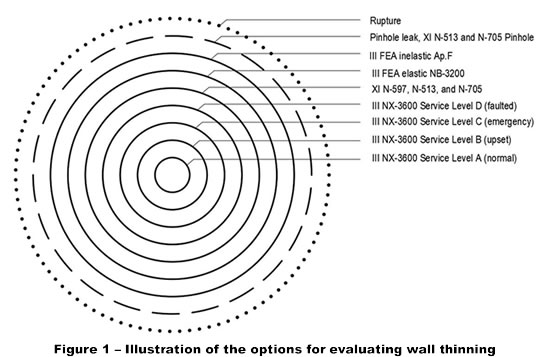Explosive Failure of Vessels
FAILURE MODE – When an explosion (either a subsonic deflagration, or a supersonic detonation) occurs in a metallic vessel, one of three things can happen:
- Case 1 – Containment: The vessel can contain the explosion, elastically as if nothing happened, or with plastic bulging.
- Case 2 – Rupture: The vessel can rupture, without ejecting fragments. The rupture can be a fish-mouth ductile tear, or a more brittle running crack.
- Case 3 – Fragmentation: The vessel can rupture and fragment. There can be as little as a single fragment, for example when the top of a ground-anchored vessel takes off like a rocket, leaving behind the its anchored bottom, or as many as dozens of fragments of different sizes.
PREDICTION – Can we predict which of the three failure modes will take place? In most cases, yes. Let’s explain what we mean by “in most cases”:
CONTAINMENT – We can predict analytically (by closed-form solutions) in many cases, and numerically (by finite element analysis) in all cases whether (1) will take place; with three exceptions: (a) If the vessel contains mechanical joints (such as gasketed bolted joints, or grooved couplings), (b) If the vessel welds have fabrication flaws, or (c) if the vessel is damaged by corrosion (wall thinning or cracking) or embrittlement. If the flaws in (2) and the damage in (3) are well characterized, then even these cases can be predicted analytically or numerically. In fact there is an ASME VIII Division 3 Code Case 2564 “Impulsively Loaded Vessels” which spells out the methods and criteria to design a pressure vessel to contain a single or repeated explosions.
FRAGMENTATION – So, we can tell (with the exceptions described) whether a vessel will contain the explosion or fail. If the vessel will fail, can we predict whether it will rupture (Case 2) or fragment (Case 3)? The answer to this question is based on experimental ballistics data and tearing energy formulation. Both methods (experimental and energy formulation) have been established for cylindrical bodies, i.e. the vessel shell; but not for flat plates or formed heads. The answer to the question of fragment prediction is therefore positive for the cylindrical shell and negative for the formed or flat heads. Note that the three restrictions (a)(b)(c) listed under CONTAINMENT apply here too.
WHERE TO START – The 1983 textbook, “Explosion Hazards and Evaluation,” by Baker, Cox, Westine, Kulesz, and Strehlow (Elsevier) is an excellent reference to understand the general aspects of explosive failures. Price, in his 1998 paper “An Acetylene Gas Cylinder Explosion,” ASME J. of Pressure Vessel Technology, Vol. 120, pp. 62-68, gives an elegant and straightforward energy-based criterion to determine the potential for fragmentation of a metallic cylindrical shell. This paper could be a good starting point for the assessment of fragmentation, but this assessment requires the knowledge of the explosion pressure time-history (the plot P(t)), and temperature time-history (the plot T(t)), although in most cases the damage is caused by P(t) with T(t) trailing the pressure.
FRAGMENT CHARACTERISTICS – For the purpose of safety analysis it is often necessary to predict the distribution of fragment sizes and velocities in order to determine whether the fragments can be lethal, and at which distance. This level of detail is possible thanks to the statistical analysis of experimental data developed by ballistic researchers.
FRAGMENT SIZE – For example, for fragment size distribution, refer to the 2008 Report UFC 3-340-02, “Structures to Resist the Effects of Accidental Explosions,” by the Unified Facility Criteria (UFC) of the U.S. Department of Defense; and Grady’s 2006, “Fragmentation of Rings and Shells – The Legacy of N.F. Mott,” (Springer-Verlag, Berlin Heidelberg. New York.); and Gurney’s “The Initial Velocity of Fragments from Bombs, Shells,” by the Army Ballistic Research Laboratory Report BRL 405, 1943.
FRAGMENT VELOCITY – For fragment velocity distribution, refer to the 1984 paper by Baum, “The Velocity of Missiles Generated by the Disintegration of Gas-Pressurized Vessels and Pipes,” ASME J. of Pressure Vessel Technology, Vol. 106, November, pp. 362-368; and the 2008 paper by Kasahara, “Impulse Generation by an Open Shock Tube,” AIAA Journal, Vol. 46, No. 7, July, pp.1593-1603.
PENETRATION – If the next question is to design a shield against the fragments, then there are several test-based empirical formulas for the penetration of fragment missiles through metallic plates or concrete walls, for example Christman, D.R., and J.W. Gehring, “Analysis of High-Velocity Projectile Penetration Mechanics,” Journal of Applied Physics, Vol.37, Number 4, 15 March 1966, pp.1579-1587.
BLAST WAVE – Another effect of the explosive rupture of a vessel that can lead to injury and structural damage is the blast wave that emanates from the explosion. Here, things are simpler than for fragmentation, since there are well-established, experimentally-based, formulas for the prediction of blast wave damage from an explosion, as a function of the explosion pressure and the vessel volume (which together will lead to an equivalent TNT charge), and distance to the target.






